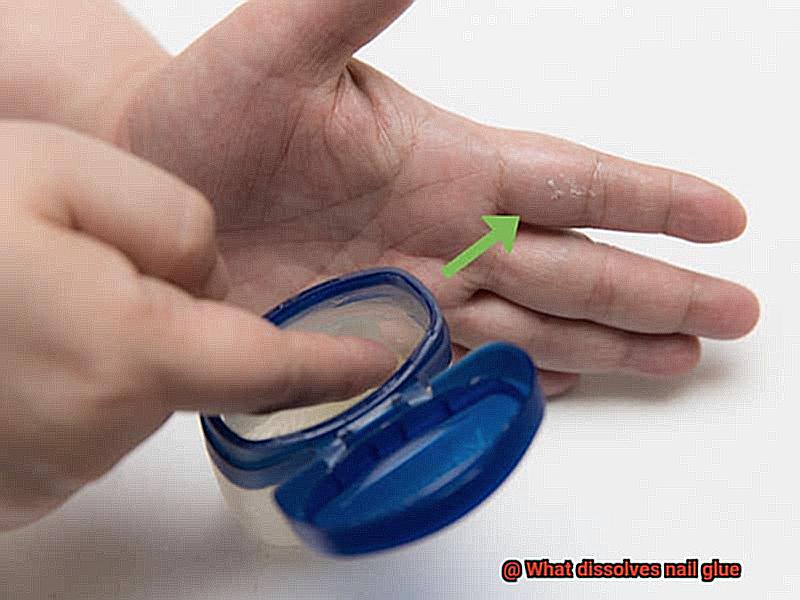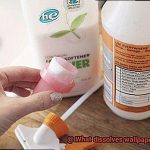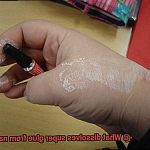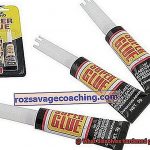Struggling with that stubborn nail glue that just won’t budge?
Whether you’re a nail art aficionado or simply love a fresh coat of polish, removing nail glue can be a real pain. But don’t fret, because I’ve got the ultimate solution to this sticky situation.
In this blog post, we’ll dive into the world of nail glue and explore the substances that can effectively dissolve it. From everyday household items to specialized removers, I’ll give you all the deets on how to bid farewell to that pesky glue and say hello to perfectly clean nails.
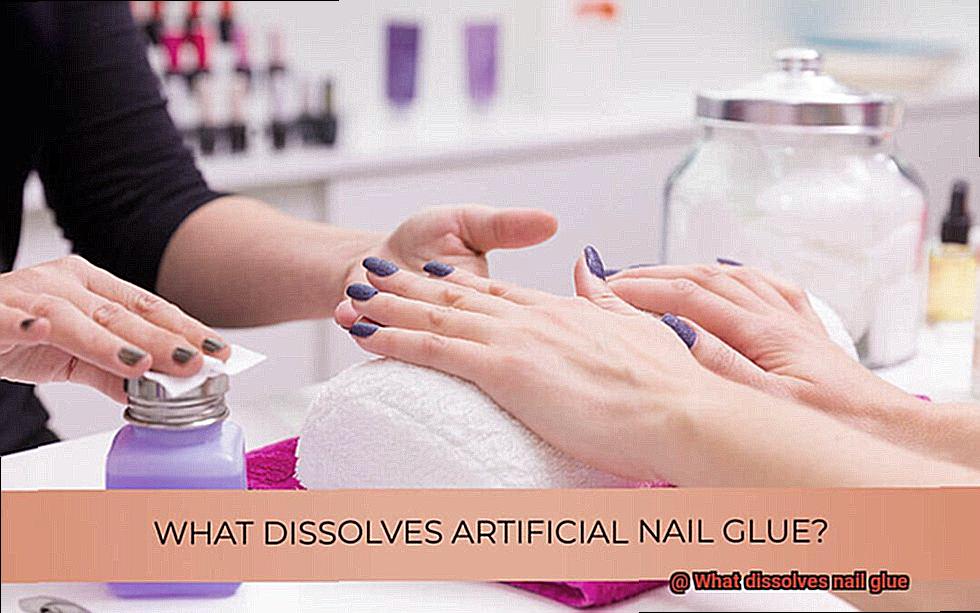
So, let’s jump right in and uncover the secret behind dissolving nail glue hassle-free.
The role of acetone in dissolving nail glue
Contents
- 1 The role of acetone in dissolving nail glue
- 2 Using pure acetone versus acetone-based nail polish removers
- 3 Alternative solvents for dissolving nail glue
- 4 Precautions when using solvents to dissolve nail glue
- 5 Tips for removing stubborn or excessive amounts of nail glue
- 6 Removing residue after dissolving nail glue
- 7 Preventing future issues with nail glue
- 8 Common misconceptions about dissolving nail glue
- 8.1 Misconception #1: Acetone is the only solution.
- 8.2 Misconception #2: Soaking nails for longer is better.
- 8.3 Misconception #3: Pure acetone is better than nail polish remover.
- 8.4 Misconception #4: Scraping or peeling off the glue is easier.
- 8.5 Misconception #5: Hot water or steam can dissolve nail glue.
- 8.6 Misconception #6: Dried and hardened glue can’t be dissolved.
- 9 Conclusion
Nail glue can be a fierce opponent when it comes to removing it from your nails or other surfaces. But fear not, for there is a secret weapon that nail enthusiasts and professionals alike swear by: acetone.
In this article, we will delve into the intriguing chemical properties and mechanisms that make acetone the ultimate solution for dissolving nail glue, allowing you to achieve flawless and beautiful nails with ease.
The Power of Acetone:
Acetone, a clear and colorless liquid with a potent odor, possesses a remarkable ability to dissolve nail glue. Its true strength lies in its capability to break down the molecular structure of cyanoacrylate, the adhesive compound found in nail glue.
Cyanoacrylate forms an unyielding bond when it encounters moisture, making it a formidable nail adhesive. However, acetone disrupts these bonds, causing the glue to lose its grip and dissolve into oblivion.
The Dissolving Process:
When using acetone to dissolve nail glue, there are various techniques you can employ. One popular approach is to immerse your nails in a bowl of pure acetone for approximately 10-15 minutes. Alternatively, you can saturate cotton balls with acetone and place them on your nails, securing them with aluminum foil for optimal results. This method allows the acetone to penetrate the layers of glue and effectively break it down.
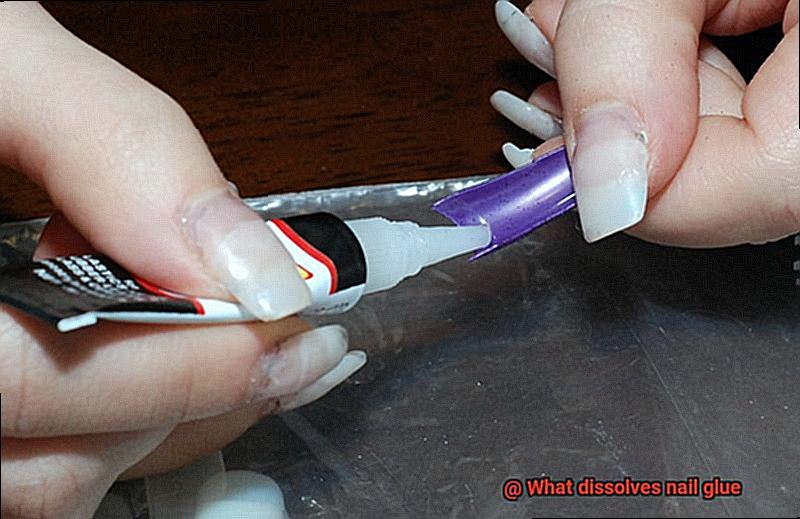
Tips for Success:
While acetone is highly effective at dissolving nail glue, there are essential considerations to bear in mind. It is crucial to use pure acetone rather than acetone-based nail polish removers, as these may contain other ingredients that dilute its potency. Additionally, prolonged exposure to acetone can cause dryness or irritation on the skin. To counteract this, remember to moisturize your hands and nails after removing the glue for a nourishing and hydrating effect.
Precautions and Alternatives:
It is vital to exercise caution when using acetone or any other solvent to dissolve nail glue. Avoid contact with the skin or eyes, as it can lead to irritation or damage. If you prefer alternatives to acetone, such as rubbing alcohol, vinegar, or lemon juice, keep in mind that these options may require longer soaking times or additional scrubbing to achieve the desired results.
Using pure acetone versus acetone-based nail polish removers
Imagine the satisfaction of completing a stunning nail art creation, only to be faced with the daunting task of removing the glue that binds it all together. Fear not, for we are about to embark on an epic battle between pure acetone and acetone-based nail polish removers. Join us as we explore the differences, considerations, and application techniques for these two gladiator solvents. Get ready to witness the clash of the titans.
Pure Acetone: The Unstoppable Force
In the realm of nail glue dissolving, pure acetone reigns supreme. Its sheer power and high concentration make it a favorite among nail enthusiasts. This mighty solvent can penetrate and dissolve glue with lightning speed.
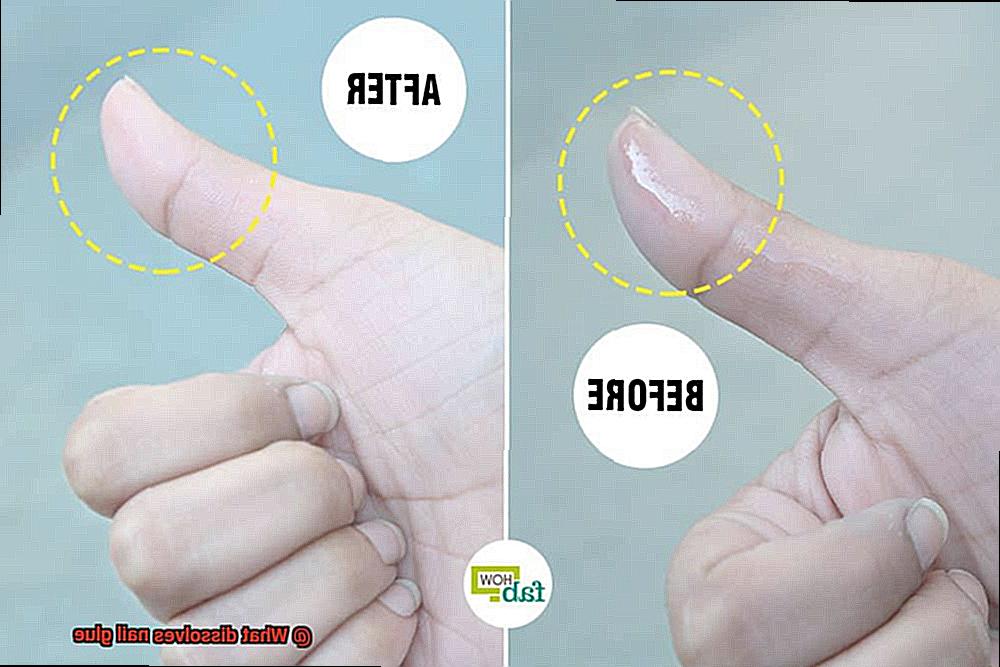
However, its strength comes at a price. Pure acetone can be harsh on your nails and surrounding skin, leaving them dry and brittle. To counteract this, use pure acetone sparingly and moisturize your nails and cuticles afterwards.
Acetone-Based Nail Polish Removers: The Gentle Alternative
For those with delicate nails or sensitive skin, acetone-based nail polish removers offer a gentler option. Although they contain a lower concentration of acetone, these removers can still effectively dissolve nail glue over time. While it may require a bit more patience compared to pure acetone, the trade-off is healthier treatment for your precious nails.
The Art of Application
Whether you choose pure acetone or an acetone-based remover, proper application techniques are crucial for victorious glue removal. Begin by saturating a cotton ball or pad with your chosen solvent. Place it on the glued area and let it work its magic for a few minutes. This allows the solvent to penetrate and break down the glue’s stronghold. Gently rub or scrape off the dissolved glue for complete removal.
A Word of Caution
While acetone is a formidable ally, it must be handled with care. Always work in a well-ventilated area to avoid inhaling the fumes. Exercise caution to prevent contact with your eyes and open wounds, as acetone can cause irritation.
In the grand battle between pure acetone and acetone-based nail polish removers, both contenders have their strengths. Pure acetone boasts swift results but risks leaving your nails dry. Acetone-based removers offer a gentler approach for those with sensitive nails.
Armed with proper application techniques and a dash of patience, you are now equipped to conquer any nail glue challenge that comes your way. So go forth, brave warriors, and dissolve those stubborn glues with confidence.
Alternative solvents for dissolving nail glue
I hold the key to dissolving that pesky adhesive without relying solely on pure acetone. Whether you have an acetone allergy or simply want to explore new options, these alternative solvents will swoop in to save the day. But remember, safety comes first. Let’s dive right into the world of alternative solvents for dissolving nail glue.
Ethyl Acetate: The Fruity Fighter
Say hello to ethyl acetate, a colorless liquid with a delightful fruity aroma. This mighty solvent is widely used in cosmetics and various industries as a solvent. When applied to nail glue, ethyl acetate breaks down the adhesive bonds, making it a breeze to remove. So bid farewell to stubborn nail glue and embrace the power of ethyl acetate.
Methyl Ethyl Ketone (MEK): The Industrial Powerhouse
Meet MEK, a clear and sweet-smelling industrial solvent that packs a punch. With its potent dissolving properties, MEK effectively breaks down nail glue. However, exercise caution. Ensure proper ventilation and avoid prolonged exposure, as inhalation or skin absorption can be harmful.
Isopropyl Alcohol: The Gentle Warrior
Also known as rubbing alcohol, isopropyl alcohol is a readily available alternative that is gentler on the skin compared to acetone. It works by softening the adhesive bonds of nail glue, making removal easier. So if you prefer a milder approach, reach for that bottle of isopropyl alcohol and let it work its magic.
Olive Oil and Coconut Oil: The Natural Heroes
For those who prefer natural remedies, look no further than your kitchen pantry for olive oil or coconut oil. These oils gradually break down the adhesive bonds over time, offering a gentler alternative to stronger solvents. While it may take longer for the glue to dissolve completely, the wait is worth it for those seeking natural solutions.
Safety First:
When using alternative solvents, prioritize safety. Always work in a well-ventilated area to avoid inhaling fumes. Wear gloves and protective eyewear to prevent skin or eye irritation. Remember, not all nail glues are created equal, so you may need to experiment with different solvents to find the perfect match for your specific glue type.
Precautions when using solvents to dissolve nail glue
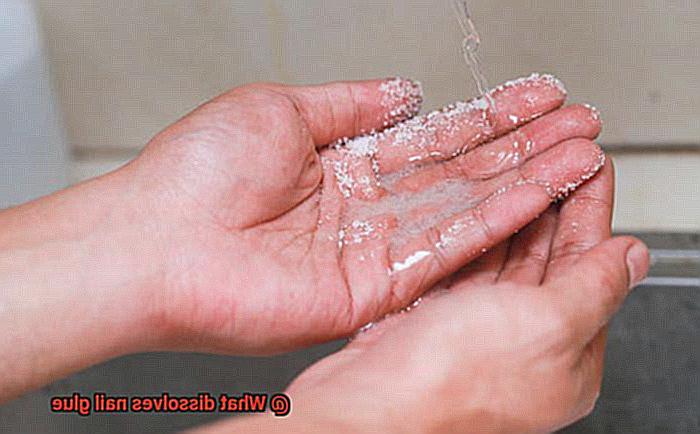
Solvents can be your secret weapon. But remember, safety should always come first when working with these powerful chemicals. In this post, we’ll cover essential precautions to ensure a safe and effective experience when using solvents to dissolve nail glue.
Create a Breathable Space:
Before diving into your nail glue removal mission, set up shop in a well-ventilated area. Solvents release fumes that can be harmful if inhaled for too long. Crack open those windows or flip on a fan to keep fresh air flowing as you work.
Guard Your Hands:
Don’t forget to protect your hands. Always wear chemical-resistant gloves when handling solvents. Shielding your skin from direct contact will prevent irritation or allergic reactions. Nitrile or neoprene gloves are perfect for the job.
Shield Those Peepers:
Your eyes deserve protection too. Invest in safety goggles or glasses to guard against splashes or vapors that could irritate or harm your eyes. Keep them on throughout the process for maximum safety.
No Flames Allowed:
Solvents are highly flammable, so keep them far away from potential ignition sources. Choose a designated work area, free from open flames, sparks, lit candles, or smoking materials that could spell danger.
Less is More:
Remember, less is more. Use only the necessary amount of solvent to dissolve the nail glue. Using excessive amounts not only increases exposure risk but also creates a messy situation that’s harder to handle.
Patch Test First:
Before applying solvent directly to your nails, perform a patch test on a small area of skin. This will help identify any adverse reactions or sensitivity to the solvent before proceeding with the nail glue removal process.
Follow Instructions Closely:
Carefully read and follow the manufacturer’s instructions. Different solvents may have specific guidelines for usage, dilution, or application methods. Adhering to these instructions ensures both safety and maximum effectiveness.
Proper Storage:
After use, tightly seal the solvent container and store it in a cool, dry place away from direct sunlight. Keep it out of reach of children and pets to prevent accidental ingestion or misuse.
Dispose Responsibly:
Proper disposal is crucial. Never pour solvents down the drain or throw them in the trash unless instructed to do so. Contact your local waste management facility for guidance on proper disposal methods.
Tips for removing stubborn or excessive amounts of nail glue
We’ve all faced the frustrating challenge of dealing with stubborn nail glue residue after removing artificial nails or repairing a broken one. But fret not. With a few simple household items and techniques, you can effortlessly bid adieu to that clingy glue without causing harm to your nails. Get ready to conquer this common nail woe with our tried-and-true methods.
Acetone: The Mighty Glue Fighter
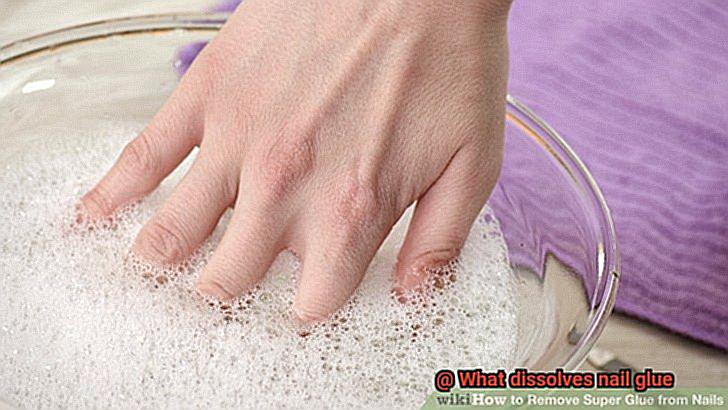
Acetone, the superhero of solvents, is your ultimate weapon against stubborn nail glue. To unleash its powers, saturate a cotton ball or pad with acetone and place it on the affected area.
Wrap your finger in aluminum foil, as if donning a shiny superhero cape, to keep the acetone in place. Let it work its magic for 10-15 minutes, softening the glue. Then, wield a cuticle pusher or an orange stick to gently scrape off the weakened glue. Repeat if necessary until total victory is achieved.
Warm Soapy Water: The Gentle Approach
For those seeking a milder method, warm soapy water is your secret weapon against stubborn nail glue. Begin by soaking your fingers in warm soapy water for 10-15 minutes. Visualize the warm water and soap joining forces to weaken the glue’s hold.
As the glue softens, employ a soft brush or toothbrush to gently scrub away the remaining residue. Rinse your hands with clean water, and behold your beautifully clean nails.
Olive Oil: Nature’s Helper
Nature comes to the rescue with olive oil as a natural remedy to dissolve nail glue without causing any harm. Warm up some olive oil and immerse your fingers in its soothing embrace for 10-15 minutes. Picture the gentle intrusion of olive oil seeping into the glue, rendering it more pliable. After the soak, employ a cuticle pusher or an orange stick to delicately scrape off the softened glue. Enjoy the moisturizing benefits of olive oil as an added bonus.
Nail Polish Remover: The Classic Contender
If you have a trusty bottle of nail polish remover containing acetone, consider yourself fortunate. Soak a cotton ball or pad in the nail polish remover and apply it to the affected area for 10-15 minutes. The acetone will engage in a battle against the adhesive properties of the glue, ultimately leading to its defeat. With a cuticle pusher or an orange stick as your valiant ally, remove the conquered glue. Witness your nails emerging victorious in this epic clash.
Removing residue after dissolving nail glue
Removing residue after dissolving nail glue can be quite the challenge, but fear not. I am here to share some expert tips and techniques that will help you conquer that pesky residue once and for all.
The most effective method for removing residue is using acetone. Acetone is a powerful ingredient commonly found in nail polish removers, and it works wonders at dissolving nail glue. Soak a cotton ball or pad in acetone and gently rub it over the affected area. As if by magic, the glue will start to break down, making it easier to remove.
But what if you’re dealing with stubborn residue that just won’t budge? In that case, try using a wooden cuticle stick or an orange stick. Use the rounded end of the stick to gently scrape off the residue from your nails. Remember, a light touch is key here to avoid any damage to your precious nails.
If scraping isn’t your thing, don’t worry. You can also use a nail buffer or a fine-grit nail file to remove the residue. With careful precision, buff or file away the residue until it disappears completely. And remember, be gentle – your nails deserve only the best treatment.
Once you’ve successfully bid farewell to the residue, it’s time to show your nails some love. The acetone and other methods used to dissolve the glue can be drying, so make sure to moisturize your nails and cuticles. Apply a nourishing cuticle oil or hand cream to restore moisture and prevent any further damage.
Now, for those who prefer natural alternatives, there’s good news. Olive oil or coconut oil can also do the trick. Simply apply a small amount of oil onto a cotton ball or pad and gently rub it over the affected area. The oil will work its magic by dissolving the residue, making it easier to remove.

And don’t forget the finishing touch – wash your hands with soap and warm water to ensure all traces of glue and oil are gone. Your nails will be left clean, beautiful, and residue-free.
Preventing future issues with nail glue
Nail glue is a game-changer when it comes to keeping our manicures on point. However, sometimes it can cause more trouble than it’s worth, leaving us with messy residue or weakened adhesive. But fret not. As an expert in preventing future issues with nail glue, I’m here to share valuable tips and techniques to minimize these problems and ensure flawlessly beautiful nails.
Proper application:
To start off on the right foot, ensure your nails are squeaky clean before applying the glue. A thorough cleaning removes any oils or lotions that may hinder the bond. Remember, dry nails are the key to a strong adhesive. Apply the glue in thin, even layers, avoiding excessive amounts that could lead to spills or drips.
Storage and handling:
Don’t underestimate the importance of proper storage and handling. Store your nail glue in a cool, dry place away from direct sunlight or heat sources. Extreme temperatures can alter its consistency and render it less effective. After each use, tightly seal the bottle to prevent drying out or leaking, preserving its potency for future applications.
Avoiding exposure to water:
Nail glue and water don’t mix well. Prolonged exposure to water can dissolve the glue and ruin your manicure. So, be cautious when engaging in activities like washing dishes, swimming, or taking long showers after applying nail glue. If your nails do get wet, gently pat them dry to minimize any damage.
Avoiding excess pressure:
Your nails are not tools. Applying excessive pressure on them can weaken or break down the nail glue. Treat your nails with care and avoid using them to open cans or containers or as makeshift tools. By being mindful of these habits, you’ll preserve the integrity of the nail glue and keep your manicure intact.
Regular maintenance:
Stay vigilant by regularly checking your nails for any signs of lifting or peeling of the glue. Address these issues promptly to prevent further damage. If you notice any gaps or loose edges, gently apply a small amount of nail glue to secure them back in place. Additionally, avoid excessive filing or buffing, as these actions can weaken the glue and make it more susceptible to damage.
Common misconceptions about dissolving nail glue
I’m here to debunk some common misconceptions about dissolving nail glue and provide you with accurate information on how to effectively remove it.
Misconception #1: Acetone is the only solution.
While acetone is a popular choice for dissolving nail glue, it’s certainly not the only solution out there. Don’t panic if you don’t have any acetone on hand – there are other alternatives that can be just as effective.
Misconception #2: Soaking nails for longer is better.
Some people believe that soaking their nails in acetone for a longer period of time will speed up the glue removal process. However, this couldn’t be further from the truth. Acetone requires time to break down the glue, and soaking your nails for too long can actually lead to dryness and damage. So, be patient and give the acetone enough time to work its magic.
Misconception #3: Pure acetone is better than nail polish remover.
Yes, pure acetone may work faster, but it can also be harsh on your nails and cuticles. Nail polish remover that contains acetone can still effectively dissolve nail glue without causing as much damage. So, don’t feel like you have to use pure acetone if you’re concerned about the health of your nails.
Misconception #4: Scraping or peeling off the glue is easier.
It may be tempting to scrape or peel off the nail glue, thinking it will be a quicker and easier method. But hold on. This can actually be extremely damaging to your nails and can result in thinning, peeling, or even breakage. It’s always best to dissolve the glue using a suitable solution rather than forcibly removing it.
Misconception #5: Hot water or steam can dissolve nail glue.
While heat can help soften the glue, it’s not enough to completely dissolve it. Hot water or steam can be used in combination with a suitable dissolving solution to enhance the effectiveness of the process. So, don’t rely on heat alone to get rid of that stubborn glue.
Misconception #6: Dried and hardened glue can’t be dissolved.
Think that once nail glue has dried and hardened, there’s no hope of dissolving it? Think again. With the right solution and proper technique, even dried and hardened nail glue can be effectively dissolved. So, don’t give up on those nails just yet.
uJohVi5GVvo” >
Also Read: How To Remove Glue From Hands?
Conclusion
Nail glue can be quite stubborn, sticking to your nails long after you’re done with it.
But fear not, there are solutions that can dissolve this adhesive nightmare. One option is acetone, a powerful solvent commonly found in nail polish removers.
Acetone breaks down the chemical bonds of the glue, allowing you to easily remove it from your nails. Another alternative is rubbing alcohol, which can also help weaken the glue’s grip.
Simply soak a cotton ball in either acetone or rubbing alcohol and gently rub it over the glued area until the adhesive starts to loosen. For those looking for a more natural approach, lemon juice or vinegar can be effective in dissolving nail glue as well.
These acidic liquids work by breaking down the glue’s structure, making it easier to wipe away.

